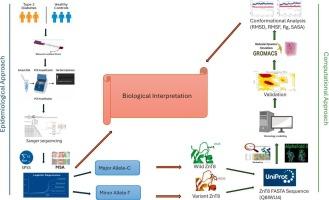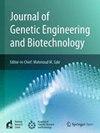Loss-of-function variant of SLC30A8 rs13266634 (C > T) protects against type 2 diabetes by stabilizing ZnT8: Insights from epidemiological and computational analyses
IF 2.8
Q3 Biochemistry, Genetics and Molecular Biology
Journal of Genetic Engineering and Biotechnology
Pub Date : 2025-09-13
DOI:10.1016/j.jgeb.2025.100565
引用次数: 0
Abstract
The loss-of-function variant rs13266634 (C > T) in SLC30A8 has been linked to type-2-diabetes (T2D) susceptibility with conflicting findings. We investigated its role among T2D patients of Bangladesh. The rs13266634 (C > T) variant results in an arginine-to-tryptophan (p.R325W) substitution of SLC30A8-encoded zinc transporter protein, ZnT8. As zinc is crucial for insulin-crystallization for storage, we analyzed its wild-type (WZnT8) and variant (MZnT8) protein conformations via molecular-dynamics (MD) simulations. For the epidemiological analysis, a case-control study was conducted with 90 T2D patients from a diabetic-patient-cohort and 90 gender-matched healthy-controls. Genomic DNA was isolated from blood samples and genotyped by Sanger sequencing. MD simulations, spanning over 100 ns, were executed using GROMACS v2024.4. The homozygous wild CC-genotype was significantly more frequent in T2D patients (66.7 %) than in control (50.0 %) and was increasing T2D risk, with adjusted odds-ratio (ORadj) of 2.25 under dominant model. Conversely, the polymorphic TT-genotype showed a protective effect, with an ORadj of 0.196 (95 % CI:0.045–0.850, p = 0.029) in an additive model. MD simulations revealed that MZnT8 variant exhibited higher structural stability, lower flexibility and a more compact conformation than WZnT8. In conclusion, the polymorphic TT-genotype of SLC30A8 plays a protective role in T2D susceptibility. Its protein variant, MZnT8, adopts a stable, compact conformation with lower flexibility, which may decrease zinc transport in insulin secreting granules and impair insulin crystallization. This structural adaptation could enhance glucose-stimulated insulin secretion and ultimately contribute to T2D protection.

SLC30A8 rs13266634 (C b> T)功能缺失变体通过稳定ZnT8来预防2型糖尿病:来自流行病学和计算分析的见解
SLC30A8中的功能缺失变体rs13266634 (C >; T)与2型糖尿病(T2D)易感性有关,但研究结果相互矛盾。我们调查了它在孟加拉国t2dm患者中的作用。rs13266634 (C >; T)变异导致slc30a8编码的锌转运蛋白ZnT8的精氨酸到色氨酸(p.R325W)替代。由于锌对胰岛素结晶储存至关重要,我们通过分子动力学(MD)模拟分析了其野生型(WZnT8)和变异型(MZnT8)的蛋白质构象。为了进行流行病学分析,对来自糖尿病患者队列的90例T2D患者和90例性别匹配的健康对照组进行了病例对照研究。从血液样本中分离基因组DNA,并通过桑格测序进行基因分型。使用GROMACS v2024.4执行了超过100 ns的MD模拟。纯合子野生cc基因型在T2D患者中的发生率(66.7%)明显高于对照组(50.0%),并增加了T2D的风险,优势模型下校正比值比(ORadj)为2.25。相反,在加性模型中,多态性tt基因型表现出保护作用,ORadj为0.196 (95% CI: 0.045-0.850, p = 0.029)。MD模拟结果表明,MZnT8变体比WZnT8具有更高的结构稳定性,更低的柔韧性和更紧凑的构象。综上所述,SLC30A8多态性tt基因型对T2D易感性具有保护作用。其蛋白变体MZnT8采用稳定致密的构象,柔韧性较低,可能减少锌在胰岛素分泌颗粒中的运输,损害胰岛素结晶。这种结构适应可以增强葡萄糖刺激的胰岛素分泌,最终有助于T2D保护。
本文章由计算机程序翻译,如有差异,请以英文原文为准。
求助全文
约1分钟内获得全文
求助全文
来源期刊

Journal of Genetic Engineering and Biotechnology
Biochemistry, Genetics and Molecular Biology-Biotechnology
CiteScore
5.70
自引率
5.70%
发文量
159
审稿时长
16 weeks
期刊介绍:
Journal of genetic engineering and biotechnology is devoted to rapid publication of full-length research papers that leads to significant contribution in advancing knowledge in genetic engineering and biotechnology and provide novel perspectives in this research area. JGEB includes all major themes related to genetic engineering and recombinant DNA. The area of interest of JGEB includes but not restricted to: •Plant genetics •Animal genetics •Bacterial enzymes •Agricultural Biotechnology, •Biochemistry, •Biophysics, •Bioinformatics, •Environmental Biotechnology, •Industrial Biotechnology, •Microbial biotechnology, •Medical Biotechnology, •Bioenergy, Biosafety, •Biosecurity, •Bioethics, •GMOS, •Genomic, •Proteomic JGEB accepts
 求助内容:
求助内容: 应助结果提醒方式:
应助结果提醒方式:


